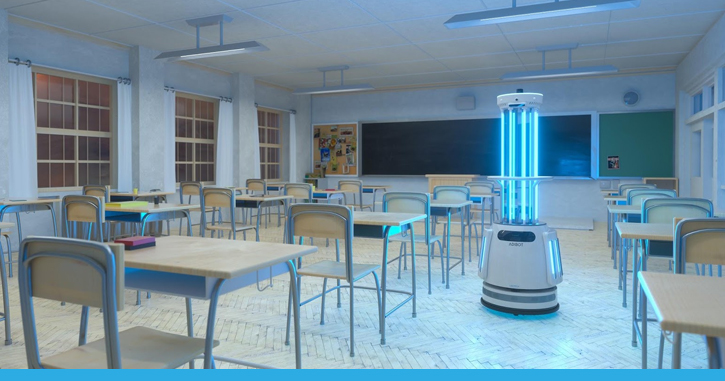To date, the Consumer Electronics Show stands as one of the world’s most influential technology events in the world, providing possibilities for new innovations to be showcased for all to see. Countless businesses are left eager to demonstrate their plans for the future, and what their technological advancements would do for the world. With this year’s show held strictly virtual during Jan. 11-14, 2021, an incredible amount of modernistic technology was introduced to the public.
However, UBTECH has taken the spotlight in context of the current global concern: fighting COVID-19. With their newly introduced ADIBOT technology, the company has set high hopes for schools and other buildings to safely open once more.
What is the ADIBOT?
The Adibot is one of UBTECH’s newly introduced technology at the CES 2021, implementing the use of UV-C to disinfect surrounding perimeters to a hospital-grade scale. While offered in two models, one being the Adibot A and the other the Adibot S, they share most qualities. The robots’ cylindrical shape offers a 360 degree radiance angle that allows eight UV-C germicidal lamps to sanitize a 1,000 square feet room in a little over a minute. Although most of UBTECH’s robots feature slender and modern designs, the company focused on the sole purpose of cleaning when designing the Adibots with their large size, making each design weigh over 200 pounds.
Since the process of sanitization involves UV-C rays — which are harmful for organisms — the Adibot is equipped with an arrangement of motion sensors and a RGB camera to detect whether any person is in the room while it is cleaning. Alongside this feature, the robot announces, in 30 second intervals, that it is sanitizing a room and no one should come near it. Additionally, the robot was not only created to target COVID-19, as the settings of the Adibot can be altered to disinfect rooms of other viruses and germs as well. This makes the Adibot an asset for environments that are commonly contaminated, such as hospitals.
Returning to the detail of the two models being made, the Adibot A is just considered a more advanced version of the other. Its defining feature is the ability to roam around in buildings on its own, while the Adibot S requires someone to pull it along with them. Other than that, the former model includes a higher guarantee of safety than the latter, concluding the differences between both.
However, with their few differences, both models are sold at different prices. The Adibot S, which will be released this month, costs $20,000, with the Adibot A being planned to sell for $40,000 in May. What’s important to note is the prices of both bots. Their target consumer base was not for any normal consumer, instead leading UBTECH to purposefully make their technology affordable to organizations such as schools. To an extent, UBTECH plans on providing Adibots for $15 a day in any case that an institution cannot pay the full price upfront.
What is UV-C and How Does it Work?
Now that Adibots have been introduced — what is the science behind UV-C and disinfecting?
In general aspects, UV rays are proven to be harmful for numerous reasons, ranging from the detriment of eyes and skin. Similar detrimental factors are found for cells. When biological organisms are left uncovered to a deep amount of UV-C — which are simply UV rays ranging from 200-300 nanometers — the rays are absorbed by DNA, RNA and proteins. However, this absorption only proves itself harmful for the organism. When proteins absorb UV rays, they then disrupt cell walls and at some point, lead to death of the cell. For the scenario of DNA and RNA, the absorption — usually by thymine bases — causes the inactivation of double helix strands by forming thymine dimers. These dimers are unneeded yet created due to UV radiations, and if enough of the said dimers are present, it leads to a disruption in cell replication. Such disruptions in cell replication result in no further replicas of the cell — their duplication is put to a halt.
With this information in mind, scientists were able to experiment with the positive use of UV rays and implement them into a form of disinfecting surfaces, as done so by UBTECH. However, it is vital to understand that the process comes with risks, for UV-C can be proven harmful to humans. The so-called thymine dimers that assist in stopping the spread of germs also become a staple cause of skin cancer in humans, emphasizing the potential danger of UV-C.
Will the ADIBOT’S UV-C Disinfecting be Successful?
Although the robot is efficient in its work, there is still a need of slight improvement. As expected of any relatively new technology, the Adibot’s use of UV rays in disinfecting aspects comes along with a setback: the scale in which it can clean. Despite its 360 degree radiance angle allowing it to sanitize the entire room of which it is in, hidden corners and objects will not be cleaned by the robot. To put it in simpler words, the Adibot only cleans what it sees.
In the end, the Adibot is still a technological breakthrough that serves as a prime step towards the prevention of COVID-19. With a foundation to begin with, further advancements can be made to bring out the utmost capability of UV-C disinfecting. For now, we can only wait and anticipate the feedback of UBTECH’S Adibots once both models are available by May of this year.
Photo Credit: Image by UBTECH from Business Wire
Sources:
- “About UVC.” Klaran, www.klaran.com/klaran-university/about-uvc
- Gebhart, Andrew. “CES 2021: These Giant Robots Can Disinfect Classrooms and Offices with UVC Light.” CNET, CNET, 11 Jan. 2021, www.cnet.com/news/ces-2021-these-giant-robots-can-disinfect-classrooms-and-offices-with-uvc-light


Love it. I learned a lot and hope to learn more on the Adibots.